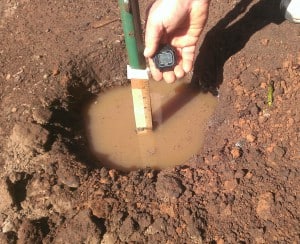How to do a percolation test

Greywater percolation tests should be conducted at the depth of discharge, ideally less than one foot.
How to do a home soil percolation test:
Step 1. Dig a 6″-12″ deep hole in your future greywater infiltration zone.
Step 2. Place a ruler (or stick marked in inches) in the bottom of the hole. The measuring device should reach the top of the hole.
Step 3. Fill the hole with water several times to saturate the soil. This may take several hours or overnight in clayey soils.
Step 4. Note the time. Fill the hole with water. When the hole is empty, note the time and calculate the time needed to drain the hole.
Step 5. Convert this rate to minutes per inch (divide the minutes by inches- 120min/5 inches is 24min/in)
Step 6. Find your percolation rate on the chart below.
| Infiltration Rate (min/inch) | Area Needed (sq.ft/gal/day) |
Example: After filling the hole four times, the water level dropped 6 inches in 75 minutes. 75 divided by 6 is about 13 minutes/ inch. |
Example: Now we multiply our greywater flow (14 gallons per day) by the area needed (0.4). 14 X 0.4= 5.6, so we need about 6 square feet of ground to absorb our daily greywater flow. |
| 0-30 | 0.4 | 13 min/inch is between 0 and 30, so we use this line. | We need 6 sq. feet for 14 gallons/day |
| 40-45 | 0.7 | ||
| 46-60 | 1.0 | If we were in this line we’d need 1.0 X 14 or 14 sq. feet. | |
| 61-120 | 2 |
Using information from Chapter 16 in the California Plumbing Code.
The California greywater code requires you to calculate infiltration area based on soil type rather than percolation rate. We think it’s more accurate to do a percolation test than to rely on soil type, but both give you important information. Regardless, if you used their chart and assumed you had very clayey soil, you’d need 1.1 square foot per gallon of greywater per day.
| Type of soil | Sq. ft/ 100 gal/day | GallonsMax. absorption/sq. ft/ 24 hrs |
| Coarse sand or gravel | 20 | 5.0 |
| Fine sand | 25 | 4.0 |
| Sandy loam | 40 | 2.5 |
| Sandy clay | 60 | 1.7 |
| Clay with considerable sand or gravel | 90 | 1.1 |
| Clay with small amount of sand or gravel | 120 | 0.8 |
So if you produced 14 gallons per day, you’d need 15.4 (round up to 16) square feet of infiltration area.
If you have 4 trees, then you’ll need an area of 16/4, or 4 square foot per tree. Most mulch basins have around 12 sq. feet of disposal area, so there’s plenty of room.
